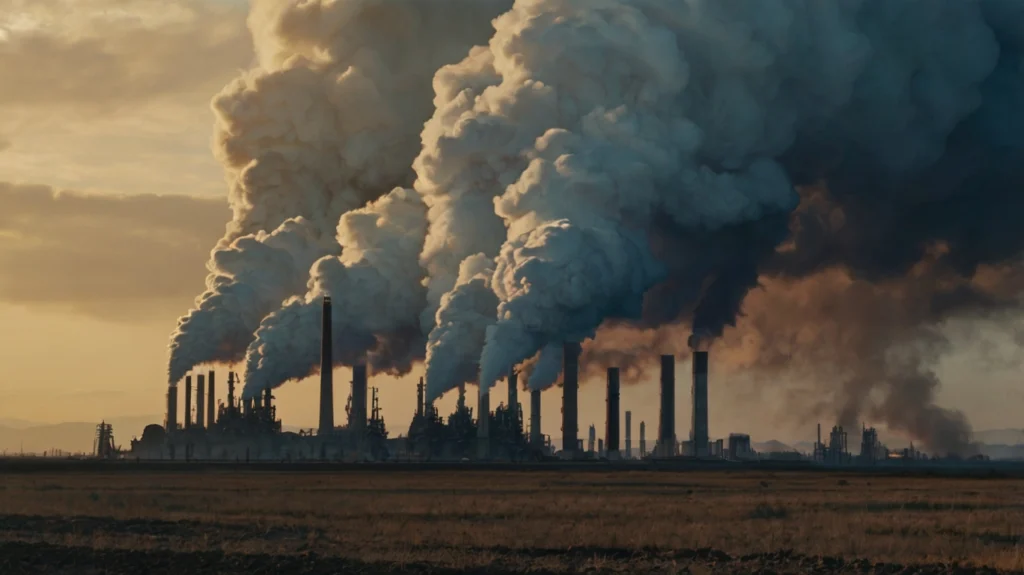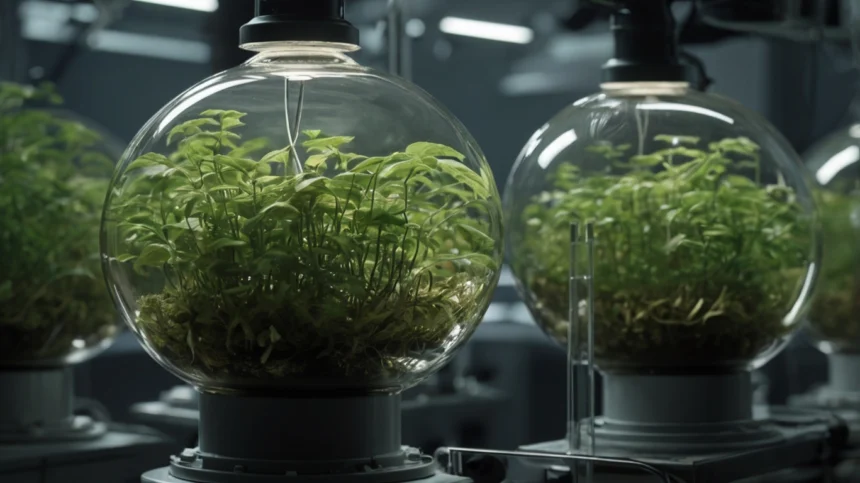Photosynthetic Organisms: Imagine a future where the skies are populated by floating algae or bacteria, acting like tiny factories capturing carbon dioxide (CO₂) and producing oxygen. Could these engineered organisms help us address climate change? In this article, we’ll dive into this fascinating idea, looking at recent research and breakthroughs that bring us closer to making this vision a reality. We’ll explore the basics for readers new to the subject and dive into technical details for the more advanced.
Harnessing photosynthetic organisms for CO₂ capture could transform climate solutions by using nature’s processes on a grand scale.
Dr. Emily Carlson, Environmental Biotechnologist
Understanding the Challenge of CO₂ and Climate Change
Why CO₂ Matters: CO₂ is one of the primary greenhouse gases that contribute to global warming. It traps heat in Earth’s atmosphere, raising temperatures and altering weather patterns. While CO₂ is naturally present and vital for life (it’s used by plants in photosynthesis), human activities, such as burning fossil fuels for energy and cutting down forests, have released unprecedented amounts of it into the atmosphere. This excess CO₂ disrupts the natural balance, leading to dangerous levels of warming and climate change.

Why Is Removing CO₂ So Hard? CO₂ is not only widely dispersed in the atmosphere but also in a dilute form, making it difficult to capture. Current CO₂ removal methods, such as Direct Air Capture (DAC), involve filtering CO₂ from the air using machines that require large amounts of energy. These technologies, though promising, are costly and still in the early stages of development. The challenge lies in scaling them up to levels needed to make a substantial impact. Additionally, these technologies can sometimes be less efficient and create other environmental burdens, such as energy consumption and resource use.
This is where photosynthetic organisms could play a pivotal role. By harnessing the natural process of photosynthesis, we could potentially create an efficient and low-energy method of capturing CO₂. Unlike traditional DAC, photosynthetic organisms like algae and bacteria can absorb CO₂ directly from the air as they grow, converting it into oxygen and biomass with minimal energy input.
How Photosynthesis Can Help: Nature’s Original Carbon Capture
Photosynthesis is the process by which plants, algae, and some bacteria convert CO₂ and sunlight into energy, releasing oxygen as a byproduct. By leveraging this natural mechanism, scientists are looking to capture CO₂ on a much larger scale, potentially reducing atmospheric CO₂ levels. This idea of “atmospheric farming” envisions a layer of photosynthetic organisms absorbing CO₂ high above, where it can then be used or safely stored.
Examples of Photosynthetic Organisms for CO₂ Capture
Algae: Algae are highly efficient at photosynthesis and can rapidly absorb CO₂, converting it into biomass. In fact, algae are being explored as a sustainable resource for biofuels. Some companies already use algae farms to capture CO₂ emissions from industrial facilities, converting these gases into fuel, food, and other useful products.
Cyanobacteria: Often referred to as “blue-green algae,” cyanobacteria have been essential to Earth’s ecosystem for billions of years. Their long history of CO₂ absorption makes them an ideal candidate for atmospheric carbon capture. Scientists are now researching ways to enhance cyanobacteria’s natural CO₂-capturing ability to maximize its effect on atmospheric CO₂ levels.
Engineered Microorganisms: Researchers are advancing genetic engineering techniques to boost photosynthetic efficiency and CO₂ uptake. For instance, scientists are designing bacteria that grow faster, absorb more CO₂, and are more resilient in varying atmospheric conditions. With these enhancements, genetically modified microorganisms could form a sustainable method of atmospheric carbon capture, operating at higher efficiencies and even converting CO₂ into other valuable compounds for long-term storage or immediate use.
Real-World Projects: From Research to Reality

- Floating Bio-Satellites: A radical idea being researched is to release floating algae or bio-satellites into the atmosphere to create a “green layer.” These bio-satellites could be made of algae or bacteria contained in small, floating units that travel in the upper layers of the atmosphere, absorbing CO₂ as they drift.
- Land-Based Algae Farms: Large algae farms have already been set up in some places to capture CO₂ emissions from industrial sources. For example, in Iceland, the Carbon Recycling International facility uses algae to convert CO₂ emissions from power plants into renewable methanol.
- Ocean-Based Algae Blooms: Another approach is to increase algae growth in oceans to enhance their natural CO₂-absorbing capabilities. However, this approach has its challenges, as changes in algae populations can disrupt marine ecosystems.
Challenges and Potential Risks of Bio-Based Carbon Capture
While the idea of floating photosynthetic organisms is exciting, there are some significant challenges and risks to consider. These include the potential for unintended ecological consequences, such as the disruption of local ecosystems if these organisms spread uncontrollably. Additionally, scaling this technology up to a global level could present logistical difficulties, including the massive amounts of resources required to deploy and maintain these organisms on a large scale. Moreover, there may be unforeseen impacts on weather patterns and biodiversity, making careful regulation and monitoring crucial.
- Unintended Ecological Imbalance: Releasing genetically engineered organisms into the environment could disrupt ecosystems. Algae blooms in the ocean, for example, can lead to “dead zones” where oxygen levels drop, harming marine life.
- Climate Impact of Bio-Satellites: Floating bio-satellites could alter atmospheric conditions, potentially impacting weather patterns. For instance, they might affect cloud formation or even the Earth’s reflectivity, leading to unintended climate effects.
- Reliability and Longevity: Floating organisms would need to survive harsh conditions in the atmosphere, such as high ultraviolet radiation and extreme temperatures. If they don’t survive long enough, they wouldn’t be effective in capturing significant amounts of CO₂.
Current Technologies: How Bioengineering Enhances CO₂ Capture
Genetic engineering has unlocked new ways to enhance photosynthetic organisms’ abilities to capture CO₂. Scientists are experimenting with methods like:
- Optimizing Photosynthesis: By modifying certain genes, scientists can make photosynthesis more efficient, meaning organisms can capture more CO₂ per energy unit.
- Improving Growth Rates: Genetic modifications allow algae and bacteria to grow faster, which could make large-scale bio-based carbon capture more viable.
- Creating Resilient Strains: Researchers are working to make organisms that can survive harsh atmospheric conditions, which is key for floating bio-satellites to be effective in the upper atmosphere.
The Sci-Fi Angle: What If We Accidentally Change the Climate?
Imagine a future where we deploy thousands of floating bio-satellites to absorb CO₂. At first, everything seems successful as CO₂ levels begin to drop, but over time, unintended effects start to emerge:
In the quest to engineer the atmosphere, we may reshape Earth’s climate in ways we never anticipated.
Dr. Alex Tanaka, Climate Change Scientist
- Unexpected Cooling: The increase in atmospheric algae changes the reflectivity of the Earth, causing a drop in temperatures beyond what was intended. This cooling could disrupt agriculture and lead to food shortages.
- Biodiversity Shifts: Changes in atmospheric composition might favor certain species over others, potentially causing a shift in biodiversity. This could impact entire ecosystems, leading to unforeseen consequences for food chains.
- Climate Feedback Loops: As bio-satellites absorb CO₂, they could trigger feedback loops that lead to new climate challenges. For example, reduced CO₂ could change cloud patterns, affecting rainfall and leading to droughts in some regions.
This sci-fi scenario shows why careful testing and regulation are crucial before implementing large-scale atmospheric interventions.
What Scientists Are Saying: Perspectives on Bio-Based CO₂ Capture
Experts are cautiously optimistic about using photosynthetic organisms to capture CO₂ but warn about the risks of large-scale deployment.
- Efficiency: Professor Sarah H. Olson from the Climate Research Center says, “Genetic engineering opens doors for highly efficient carbon capture, but the challenge is balancing effectiveness with ecological safety.”
- Ecological Impact: Dr. James Roberts, a microbiologist, emphasizes, “Introducing modified organisms into the atmosphere or oceans isn’t risk-free. We need extensive environmental impact studies to avoid tipping the balance.”
Future Prospects and Takeaways: The Road Ahead for Green Skies
As technology advances, bio-based CO₂ capture might become a key tool in the fight against climate change. Here are some steps researchers are likely to focus on in the future:

- Developing More Resilient Organisms: To make floating bio-satellites a reality, scientists will need to create organisms that can survive extreme atmospheric conditions.
- Studying Ecological Effects: Before deployment, researchers must study how bio-satellites or algae farms might affect local ecosystems and climate patterns.
- Collaborating Across Fields: Bio-based CO₂ capture involves expertise in genetics, climate science, ecology, and engineering. Interdisciplinary collaboration will be essential for developing safe and effective solutions.
- Policy and Regulation: Governments will play a crucial role in regulating the release of genetically engineered organisms into the environment to avoid unintended consequences.
- Community Awareness: Public understanding and support will be essential for the success of bio-based CO₂ capture projects. Engaging communities and educating them on the benefits and risks can build trust and promote responsible innovation.
Final Thoughts: Can Photosynthetic Organisms Give Us Green Skies?
Using photosynthetic organisms to capture CO₂ from the atmosphere is an innovative and promising idea. While the challenges are considerable, advancements in bioengineering offer a glimpse of a future where we could harness nature to combat climate change. However, as with all geoengineering efforts, we must proceed with caution, carefully balancing the benefits with potential risks.
In our quest for green skies, we’re learning that tackling climate change will require not just technological solutions but a commitment to thoughtful stewardship of our planet and its ecosystems.
Must Read : Preserving Knowledge with DNA Storage








